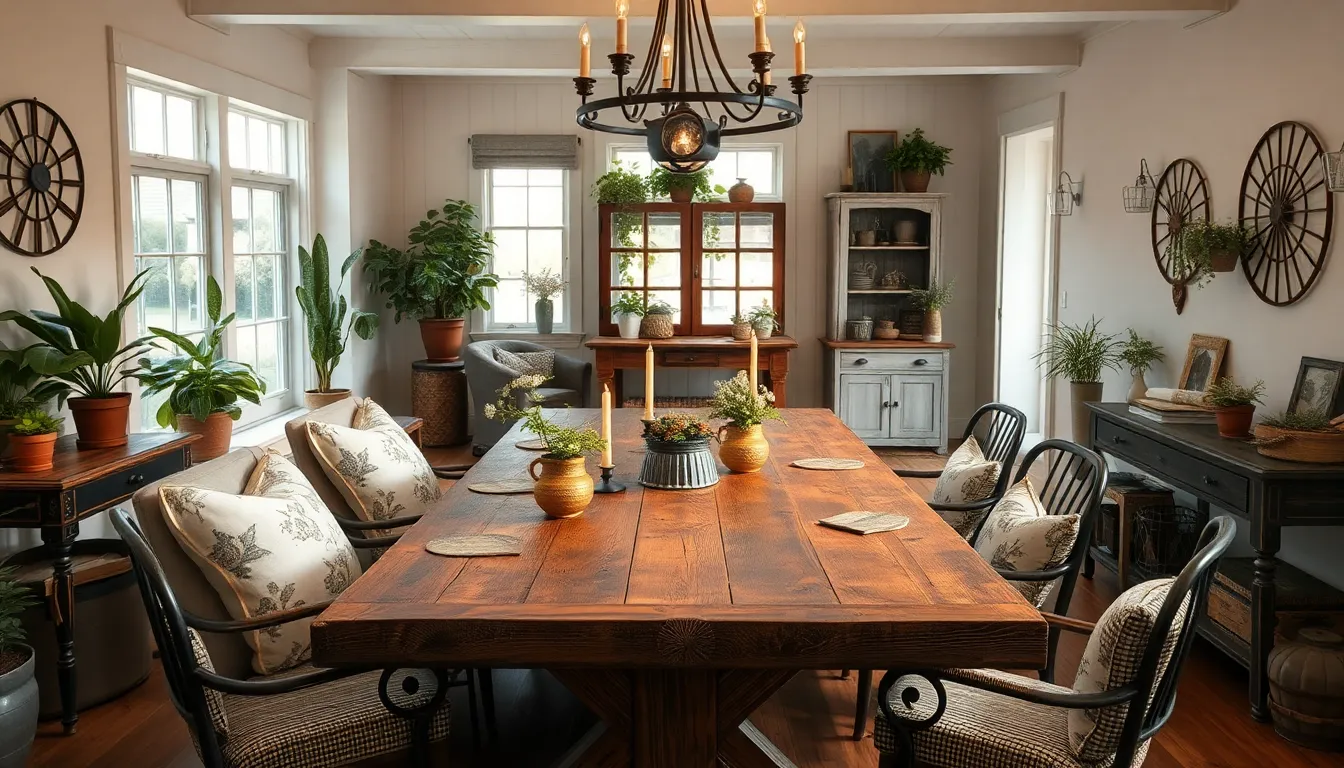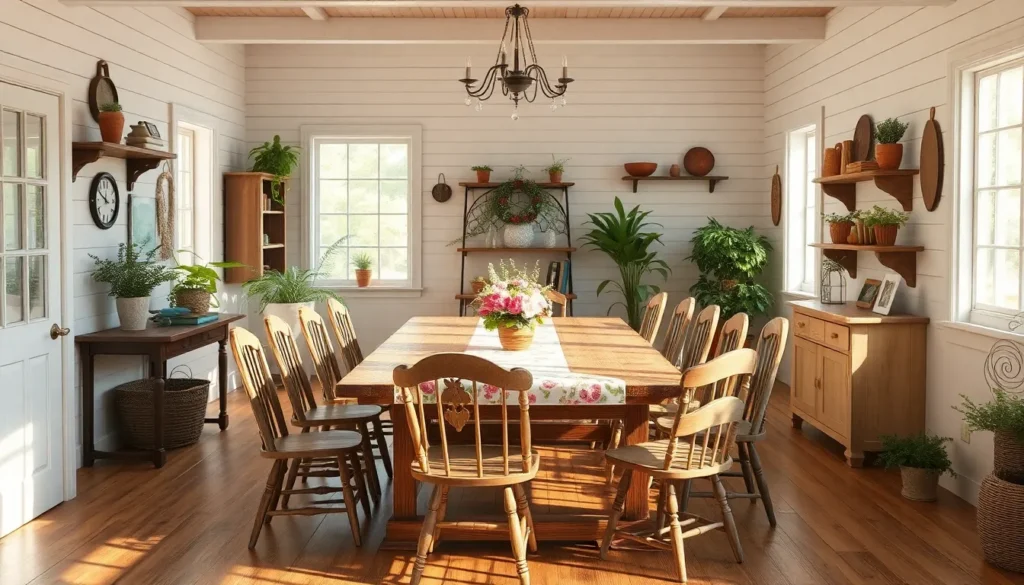Table of Contents
ToggleFarmhouse style has taken the design world by storm, blending rustic charm with modern sensibilities. This aesthetic draws inspiration from the simplicity of rural life, featuring warm colors, natural materials, and cozy furnishings. It evokes a sense of nostalgia while offering a welcoming atmosphere that feels both timeless and fresh.
At its core, farmhouse style emphasizes functionality and comfort. Whether it’s the classic shiplap walls or the inviting farmhouse table, every element serves a purpose. This design approach not only transforms spaces but also creates a lifestyle that celebrates family, community, and the beauty of everyday moments. As homeowners seek to create serene havens away from the hustle and bustle, the allure of farmhouse style continues to grow.
Overview of Farmhouse Style
Farmhouse style represents a design trend rooted in rural living, merging rustic characteristics with contemporary elements. This aesthetic emphasizes warmth through color palettes that often feature neutral tones, soft whites, and earthy shades. Natural materials like wood, stone, and metal play a critical role, imparting authenticity and a connection to nature.
Core elements of farmhouse style include functional furnishings that prioritize comfort and usability. Examples of such features are:
- Shiplap Walls: Often whitewashed or painted, shiplap adds texture and visual interest to spaces.
- Farmhouse Tables: These large, sturdy tables foster family gatherings and social interactions.
- Cozy Textiles: Fabrics like cotton, linen, and wool in plaid or floral patterns enhance comfort and approachability.
Furthermore, farmhouse style integrates vintage or antique pieces to enrich its charm. Embracing a curated look, homeowners often mix modern appliances with rustic decor, achieving a balanced aesthetic. This blend creates inviting environments designed to promote relaxation and connection, reflecting the heart of family life.
Key Characteristics of Farmhouse Style

Farmhouse style emphasizes rustic simplicity and comfort, creating a warm, inviting atmosphere. This design aesthetic incorporates specific characteristics that define its unique appeal.
Color Palette
Farmhouse style features a color palette dominated by neutral tones, soft whites, and earthy shades. These colors evoke a sense of tranquility and warmth. Accent colors, such as navy blue, muted greens, or dusty pink, may add character without overwhelming the space. A key aspect includes the use of natural hues inspired by the landscape, connecting the interior to the surrounding environment.
Furniture Choices
Farmhouse furniture blends functionality with aesthetic appeal. Large farmhouse tables serve as focal points for gatherings, while comfortable seating encourages relaxation. Pieces often showcase reclaimed wood, showcasing imperfections that highlight their rustic charm. Mix and match furniture styles, such as classic and vintage, creates a curated, lived-in look that adds depth and personality to the space.
Décor Elements
Farmhouse décor elements emphasize a sense of home and nostalgia. Decorative accents, such as wrought iron, galvanized metal, and vintage signs, enhance the rustic theme. Textiles play a crucial role, with plaid or floral patterns on cushions, throws, and curtains adding visual interest. Incorporating greenery through potted plants or fresh flowers brings life and a connection to nature, enriching the overall ambiance.
Types of Farmhouse Style
Farmhouse style encompasses various interpretations, primarily categorized into Traditional and Modern styles. Each type offers unique design elements while maintaining core farmhouse characteristics.
Traditional Farmhouse
Traditional farmhouse style reflects a classic approach focusing on timeless design. This style features:
- Architectural Elements: Gabled roofs, spacious porches, and classic window styles characterize these homes.
- Materials: Use of wood, often painted in white or muted colors, creates a rustic yet welcoming appearance.
- Color Palette: Soft whites, creams, and earthy tones enhance warmth and comfort.
- Furnishings: Heavy wooden tables, soft seating, and vintage accessories contribute to a cozy atmosphere.
- Decor: Rustic decor items, like mason jars and vintage signs, add a nostalgic touch.
Traditional farmhouse emphasizes a lived-in comfort rooted in simplicity and functionality.
Modern Farmhouse
Modern farmhouse style merges contemporary design with rustic elements. Key features include:
- Clean Lines: Aesthetic embraces open floor plans and streamlined finishes, creating a spacious feeling.
- Materials: Combination of reclaimed wood with metal accents highlights industrial influences.
- Color Palette: Neutral shades such as grays and whites dominate, often accented with bold colors for vibrancy.
- Furnishings: Multi-functional furniture pieces like slipcovered sofas and farmhouse tables promote practicality.
- Decor: Incorporation of sleek light fixtures and modern art infuses a fresh, updated look.
Modern farmhouse maintains a balance between elegance and comfort, appealing to those favoring a contemporary twist on traditional designs.
How to Achieve Farmhouse Style
Achieving farmhouse style involves thoughtful design choices that emphasize comfort, functionality, and a connection to nature. Incorporating rustic elements alongside modern touches creates a balanced aesthetic.
Tips for Interior Design
- Choose a Neutral Color Palette: Select soft whites, creams, and earthy tones. These colors enhance natural lighting and create a warm, inviting atmosphere.
- Incorporate Natural Materials: Use wood, stone, and metal for an authentic look. Reclaimed wood furniture and exposed beams provide character.
- Select Functional Furnishings: Opt for large farmhouse tables and comfortable seating. Pieces should promote family gatherings and social interaction.
- Add Cozy Textiles: Integrate plaid or floral patterns through cushions, throws, and curtains. Textiles soften the space and enhance comfort.
- Include Vintage Elements: Decorate with antique accessories such as old toolboxes or vintage signs. These items add charm and a sense of history.
- Utilize Shiplap Walls: Install shiplap for texture and visual interest. This detail emphasizes the rustic nature of farmhouse design.
Outdoor Spaces
- Create Inviting Patios: Design outdoor seating areas with comfortable furniture. Use rocking chairs or picnic tables to promote relaxation and conversation.
- Incorporate Natural Landscapes: Utilize native plants and flowers. These elements enhance the connection between the home and its surroundings.
- Use Functional Decor: Install weathered wood planters and antique garden tools. These items add charm while serving practical purposes.
- Design Open Spaces: Leave room for gathering and entertaining. An open layout encourages social interaction and family time outdoors.
- Install Practical Lighting: Use string lights or lanterns to create ambiance. Proper lighting makes outdoor areas usable during evenings.
- Emphasize Farm Features: Incorporate elements like a small vegetable garden or chicken coop. Such features reflect the farmhouse ethos and promote sustainable living.
Farmhouse style continues to captivate homeowners with its blend of rustic charm and modern functionality. This design approach not only creates inviting spaces but also nurtures a sense of community and connection. By embracing natural materials, cozy textiles, and practical furnishings, individuals can transform their homes into serene retreats that reflect their personalities.
Whether opting for traditional or modern farmhouse aesthetics, the focus remains on comfort and authenticity. As more people seek refuge from the fast-paced world, the timeless appeal of farmhouse style offers a perfect solution, ensuring that homes are not just places to live but also spaces to thrive.







